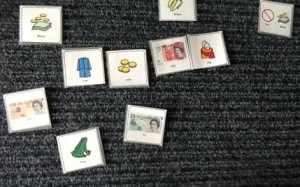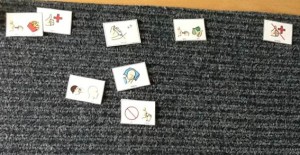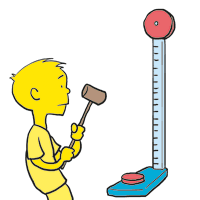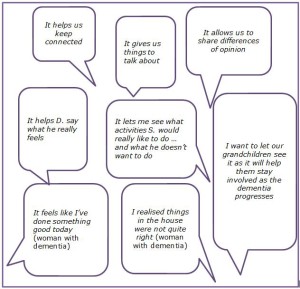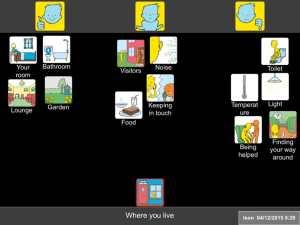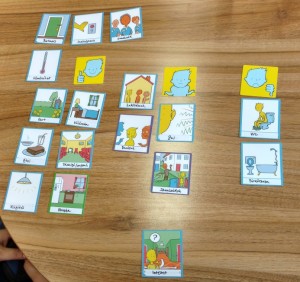Exploring sibling attitudes towards participation when the younger sibling has a severe speech and language disability
We were delighted to receive this publication from a friend and colleague, Prof Juan Bornman from Pretoria in South Africa. It reports on a study carried out with 27 typically developing children who have a younger sibling with a severe speech and language disability. Juan and her colleagues used Talking Mats to carried out an adapted structured interview to find out the views of these children on four everyday life situations identified by the WHO-ICF-CY (World Health Organisation’s International Classification of Functioning, Disability and Health, Children and Youth Version).
The four topics were:
Communication
Domestic life
Interpersonal interaction and relationships
Major life areas.
The findings showed that the children were ‘most positive towards participation in play activities with their sibling with a disability. They were also positive towards participation in household tasks. They were less positive towards communication participation and least positive about participation in interpersonal relationships’.
The following example is taken from Juan’s publication.
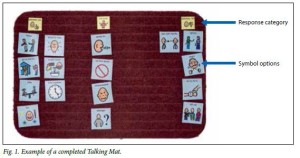
The article’s reference is:
Exploring sibling attitudes towards participation when the younger sibling has a severe speech and language disability. M Hansen, M Harty, J Bornman South African Journal of Child Health 2016 Vol. 10 No. 1
To read the full publication with details of the methods used and the results click here sibling-attitudes-2016
Delighted to introduce you to ‘The Communication Game’ : a board game for staff to improve their communication skills.
How we listen, talk and engage with people is fundamental to the quality and effectiveness of health and social care services. Although communication underpins everything we do in a work context, it can be a difficult topic for staff to talk easily about. Add to that the possibility of service users having an additional communication support need, through reasons like stroke, learning disability or dementia, then there is much potential for things to go awry and unfortunately, they often do. ‘Poor communication’ is cited as the most common cause of frustration in complaints about services.
The Communication Game was developed by Focus Games, NHS Education for Scotland (NES) and Talking Mats. It is a learning tool to help staff working in the health & social care sector increase their knowledge and skills around communication. The Communication Game is fun and easy to play. It can be played with or without a facilitator, and allows staff groups to have discussions and reflect on their communication skills. It allows them the chance to learn from each other. It will improve knowledge, but more importantly enable them to think about the small steps they can make to improve their interactions.
The project grew out of two previous projects funded by NES: Making Communication Even Better and Through a Different Door. In these projects, it was recognised that the experience of services for people with a communication support need is something of a lottery. For them, there was a considerable difference in the experience of interacting with a staff member who was empathetic and able adapt to their communication, to interacting with a member of staff who was struggling and unable to adapt their interaction. Training and understanding of inclusive communication practice is key. It has been a great privilege for Talking Mats to continue to support the work of the previous 2 projects and work with Focus Games Ltd to develop The Communication Game. Support during the development process from the Stroke Association Scotland, Capability Scotland, RCSLT, Scottish Care, Communication Forum, Queen Margaret University and NHS Ayrshire & Arran SLT Department have been invaluable, and we are very grateful; also to NHS Education for Scotland for their continued input and funding.
If you are working with staff in the health and social care sector, then this will be a great resource for you. You can get The Communication Game from the Focus Games online shop. It is guaranteed to promote laughter learning, and a touch of competitive team spirit. Most importantly, it will be a catalyst to help develop staff communication, making interactions better for people with communication support needs.
You can find out more about the game at www.communicationgame.co.uk
, and follow the game on Twitter on @Comm_Game.
Get your copy at www.focusgames.com.
Many thanks to Ruth Spilman, Senior Speech and Language Therapist, for this great blog about how she uses Talking Mats for Capacity Assessments with People with ASD/LD
I am a speech and language therapist (SLT) working in a residential provision for young people with autism spectrum disorder, learning disabilities and other co-occurring difficulties. We support young people from 7 up to the age of 20. Many of the young people are in a ‘grey area’ with a view to capacity assessments, including those aged 16-18. We support many capacity assessments, including deputy-ship for finances and care, health and welfare, as well as more individualised capacity assessments around restrictions in the environment, consent to medical interventions and making decisions about the future.
A large part of the way we support these capacity assessments is by using Talking Mats, which support people with autism who generally prefer to think about things visually. The young people are encouraged to use Talking Mats in their everyday communication, such as evaluating activities, lessons and therapy sessions to develop their skills, as well as during direct Speech and Language Therapy work. If a young person has proven their competence using a Talking Mat, we can then move on to supporting capacity assessments. As part of the process, the SLT would break down the concepts needed to be understood to identify if the individual has capacity or not. For example with finances, do they know what money is? can they organise things that are expensive and cheap? can they put items in a scale of least to most expensive? This would all be done using a Talking Mat, then followed up if they achieved this task with a range of further activities. A Talking Mat can then support activities to evidence their understanding or lack of, while also giving a young person all practicable help to communicate.
See below two examples of a young person thinking about 1) money to support their finances, and 2) things that are healthy or not.
Talking mats are used for a range of different skills and assessments in the provision I work in, but their use for capacity assessment gives the young people the most practicable support with communication and allows for clear evidence of the person’s understanding of the concepts involved. In addition to the range of items mentioned above, we have have also discussed tattoos, physical intervention and behaviour support strategies, having a lock on an individual’s bedroom door, and understanding of fantasy and reality.
Talking Mats has proved to be a truly simple but brilliant and useful tool.
Ruth Spilman, Senior Speech and Language Therapist, Specialist services in education
The Cambian Group, Dorset, BH19 1PR www.cambiangroup.com
Castle Hill High School has seen the benefits of using Talking Mats to let pupils have their say and be involved in planning outcomes. Jenna McCammon, Speech and Language Therapist & Rebecca Highton, Speech and Language Therapy Assistant, Stockport NHS Foundation Trust explain how they are using Talking Mats at Castle Hill High School.
Talking Mats has been beneficial in supporting young people with communication difficulties in school.
A Talking Mats approach has been used to support a pupil who presents with selective mutism. He started refusing to engage in lessons and activities, so school wanted to find out what he enjoys doing and how best to support him. Talking Mats allowed the speech and language therapy team to find out about his likes and dislikes at school, along with the reasons why he was refusing to engage in certain lessons. The sessions allowed the speech and language therapy assistant to build rapport with the pupil through finding out what he enjoys both in and outside of school, and the pupil communicated verbally during one of the sessions for the first time since his change in behaviour. The speech and language therapy assistant took pictures of the finished piece of work and asked permission from the pupil to share this with school staff. The speech and language therapy assistant was able to feed back the outcomes with staff and with other professionals during TAC meetings. Staff and other professionals would then request if the speech and language therapy assistant could obtain more information from the pupil, when needed, using Talking Mats.
Safeguarding – A possible safeguarding issue was suggested by a pupil during a therapy. The pupil has significant communication difficulties and so the information she was able to provide was very limited. The safeguarding officer in school requested if the speech and language therapy team could try to find out more. This was done us using Talking Mats, which allowed the pupil to share more information about the issue which was then shared with the safeguarding officer.
Motivational Interviewing is a tool used by the speech and language therapy team, both when assessing a new referral and when completing a review assessment in order to set new therapy targets. It is an opportunity for the young person to express their opinion, and can also be used to determine how much insight they have regarding their communication abilities. This is usually done verbally using a 10-point scale, however Talking Mats has been used by the speech and language therapist when assessing pupils with limited verbal ability. This allows these pupils to voice their views and have a say in their therapy planning. The findings from the Talking Mats motivational interviews then contribute to writing EHCP Reports for the pupil and are used to inform the decision-making process regarding their therapy goals.
Thanks to Jemma and Rebecca for sending these great examples. Change happens when we give young people a listening space.
This blog summarises a project we have completed providing Talking Mats training for families living with dementia. A key aspect of the work done by Talking Mats is to find ways to improve communication for families living with long term conditions. In particular dementia is a long term condition where deterioration in communication will eventually affect everyone. This makes it increasingly difficult to ensure that the person with dementia continues to be involved in decisions about their life.
We have completed a project funded by Health and Social Care ALLIANCE Scotland. Training in the use of Talking Mats was given to families living with dementia and staff who worked with these families. The Alliance Family Training final report highlights how this training helped people with dementia to communicate their views and be more involved in making decisions about their lives.
Families identified issues relating to self-management that they had not previously been aware of and new insights emerged as the following comments illustrate.(click on box to enlarge)
For some family members an important outcome was that Talking Mats helped them see that their spouse was satisfied with many aspects of his/her life. They found this very reassuring as many assumed that the person with dementia was frustrated and discontented.
The following is an example of how using Talking Mats helped with self-management.
When using Talking Mats on the topic of Where you live, G explained that he found it difficult to find his way to the toilet in the night. As a result his wife bought special senior night lights to help him which solved their problem. As a result, night times improved for both of them.
For further examples and information read the full report here Alliance Family Training final report and for further information about Talking Mats Family training please contact info@talkingmats.com
Thanks to Agnes Turnpenny for her guest blog on her research on views of people moving form institutional care in Hungary.
There are approximately 15 thousand adults and children with learning disabilities living in large institutions in Hungary. The average size of these facilities is over 100 places, and living conditions as well as the quality of care are often very poor. The Hungarian Government adopted a strategy in 2010 to close and replace these institutions with smaller scale housing in the community. Between 2012 and 2016 six institutions closed and more than 600 people moved to new accommodation. The Mental Health Initiative of the Open Society Institute and the Hungarian Civil Liberties Union commissioned a study to analyse the experiences of the deinstitutionalisation process and as part of this research we carried out some interviews to explore the views of people moving out of the institutions.
The participants – five men and four women – came from one institution in the North East of Hungary, they all had mild learning disability and some had additional mental health issues. Originally the study intended to explore the experience of moving out but due to delays in the project this was not possible. Instead, we decided to examine the expectations of moving from an institution to a smaller home that allows more independence and personalised support. Although only one of the participants had communication difficulties – thus conventional interview methods could have been utilised – I decided to use Talking Mats in order to help participants to contrast their current situation with expectations about the future.
I selected the ‘Where you live’ topic from the Social Care package with some additional images from the ‘Leisure and Environment’ and ‘Relationship’ topics. (The English labels were covered over with a Hungarian translation as most of the participants could read). The question I asked was “How do you feel about these aspects in the institution?” and “What do you think they will be like in the new home?”. (I forgot to take a mat with us, therefore we had to lay out cards on the table.)
It emerged – unsurprisingly – from the interviews that most participants anticipated the improvement of their living conditions from the move, especially better facilities (mainly bathroom and kitchen). Some also expected other positive changes, particularly less conflict with other residents, less noise and better safety –commenting on the prevalence of theft in the institution. There were also many uncertainties; people said they were unsure about how they would get on with their new housemates, how the new support arrangements with staff would work, whether the neighbours will be welcoming etc. The photos illustrate some these issues.
Overall, Talking Mats proved to be a very useful tool in interviewing participants, who really engaged with the method. The images and the completed mats encouraged further comments and explanations on issues that participants considered important with minimum prompting. The drawings were easily recognised and appropriate in the Hungarian context without any adaptations other than the labels. Finally, I felt that the use of Talking Mats in this particular situation helped to overcome some of the power imbalance between the researcher and the participants by giving them more control when handing over the images.
We are really grateful to Agnes Turnpenny from The Tizard Centre University of Kent for sharing her experience . We really value our European work and European connections.
Engaging with people who have difficulty communicating can take time and may result in misunderstandings which can cost a lot in terms of time and cost and emotion for all involved. Research and anecdotal evidence have both shown that using Talking Mats is efficient and cost effective in that staff or carers can get better quantity and quality of communication with the people they work in a shorter time with than with usual methods of communication. The average time for someone trained in Talking Mats to have a Talking Mats conversation is 15 minutes, although some people may choose to talk for longer.
In addition, staff often rely on relatives to gather information about a person’s needs and preferences. The process of gathering that information can be protracted owing to availability of family members and, because it is second-hand, is liable to misinterpretations. This in turn can lead to frustrations which can damage relationships, result in poor care and cost time.
At a practical level, the feedback from staff has been that the wipe clean, ready-made Talking Mats symbol sets give immediate access to a practical communication tool. Staff compared this favourably with the time taken to source images on-line, print them out, cut them up and develop them to a standard that is infection control compliant.
The Talking Mats team have invested their time and skills over several years to develop topics which are based on sound research. For example the Health and Well-being Resources is based on the World Health Organisation ICF, the Children and People’s Resource is based both on WHO-ICFCY and GIRFEC. The Eating and Drinking Resource has been co-produced with people with eating and drinking difficulties and a range of different professionals. The Talking Mats symbols have been carefully designed to represent both concrete and abstract topics
In addition sending staff on a Talking Mats training course results in a work force which is effectively trained in communicating with a wide range of people as well as having a bespoke communication tool. Using Talking Mats is efficient for organisations both in terms of time and costs.
It is important that we ask people with learning disability about their lives and enable them to raise any concerns. Over the past couple of years we have been developing a Talking Mat called Keeping Safe. It is a resource that gives people time to think about various aspects of their lives, and express how it is going for them.
234 staff in different parts of Scotland now have the resource and have been trained to use it. Feedback includes that using the Keeping Safe resource can improve the quality of communication for both the person with a learning disability and the staff member in the following ways :
- Staff frequently commented that using the Mats revealed things they had not known previously;
‘It gave so much information which we did not expect. It will assist in Adult Support and Protection feedback. It gave him his own say in things.’
‘allowed needs to be identified that I would not have thought to ask about, such as the smoking and taking drugs.’
- It enabled staff have a conversation about more sensitive and or difficult issues;
‘Usually when she expresses her feelings she can get either upset or angry. She did not get upset or angry at any point through doing the Talking Mats, although the subject and things she was saying was at times difficult issues.’
‘A has good communication skills but as we had a sensitive issue (personal care) to discuss I felt that a talking mat would allow us to explore this.’
- It also helped the thinker ( the thinker is the person doing the mat ) to express their thoughts clearly
‘allowed this person to disclose things that they were struggling to disclose verbally.’
- It helped with memory difficulties and kept the thinker focused on the topic
‘It helps with memory and attention as she has something visual to keep her focused.’
- The information gained reflected the thinker’s view and not the views of those around them
‘This resource gave this gentleman the power to say exactly what he was thinking and not what he thought someone wanted to hear.’
- There was a lot of positive feedback on using the resource from people with learning disabilities
‘I adore this. The mats really helped me speak about my feelings.’
- It was a quick way to get information. Initially many staff thought using the resource would take too much time but in fact were surprised to find how much information they got in a short space of time.
The stories gathered from using the resource are powerful and a final report is being prepared which will be launched at a seminar on the 19th May during learning disability week . There are still some spaces on the seminar so if you would like to attend please contact info@talkingmats.com .
We are delighted that the Scottish Government is funding a further round of Keeping Safe Talking Mats training. If you work with adults with learning disability in Scotland, and would like to apply to a Keeping Safe Talking Mats training course then please email us for dates and the application form.
Talking Mats was used as part of a Speech and Language therapy assessment for a boy with a stammer (dysfluent speech). He was very aware of his stammering and would change what he was going to say or avoid some situations because he anticipated that he would stammer. He had low self-esteem about his speech and felt that whenever anyone laughed in his class, it was to do with his stammer.
Talking Mats was used to gather information about which situations and people made speaking easier, and any situations and particular people which caused more of a challenge. The activity provided much more information than originally anticipated.
A starter mat was used to show how a Talking Mat worked, using pictures of food. He engaged well with this, and understood the process quickly. We then moved onto discussing his speech – we wrote names of people in his life and situations which involved speaking onto pieces of paper, and he placed these on the mat where he felt appropriate. We started with people and situations which appeared more positive, then gradually moved onto those it was anticipated would be more challenging.
His insight into his speech and what helped him or made speaking more difficult was impressive. We were able to use this information to compile a list of “Do’s and Don’t’s” for people he came into regular contact with. He agreed that this information could be shared with school to give them strategies to support him there.
The most powerful part of the Mat was him being able to say that he did not feel happy about talking with his big brother sometimes, because he could make fun of his speech, and this made him feel really upset. This was a powerful revelation for his Mum who had sat in on the session, as she had not realised he felt this way. After the session, the family had a chat around the table at tea-time about how his therapy session had gone that day – with Mum’s support he was able to say to his brother about how his teasing had made him feel. His older brother had thought it was all a bit of fun and hadn’t realised the impact it was having. They agreed the older brother wouldn’t tease him anymore.
When he came back for his next session, he commented on being much happier about his talking at home, and felt the activity had been really helpful. His Mum was very positive about it too, and proud of how he had managed to speak up for himself and be able to say how other people could help him with his talking.
Our thanks to Kirsten Taylor, Speech and Language therapist for sharing this powerful story
What are the top 10 blogs for using Talking Mats with adults? Over the years we have posted lots of blogs on different aspects of our framework . If you are working with adults with communication disability these blogs maybe particularly helpful
- Where is the best place to start using the Talking Mats health and well-being resource?
- A blog from Denmark which highlights the effectiveness of using Talking Mats with people with dementia
- Goal setting with a woman with Multiple sclerosis
- Using the app with someone with aphasia
- The development of a resource to help people with learning disability raise concerns
- How can Talking Mats support Capacity to make decisions
- Involving people in their decisions about eating and drinking
- Thoughts on using Talking Mats with people with dementia to explore mealtimes
- Using Talking Mats with someone with a learning disability and dementia
- Use in a rehab setting in South Africa
If you want to explore our resource and training more please visit our shop
 Online training login
Online training login 

